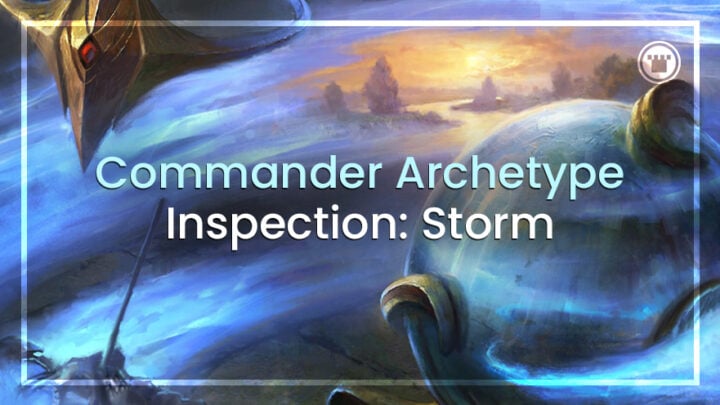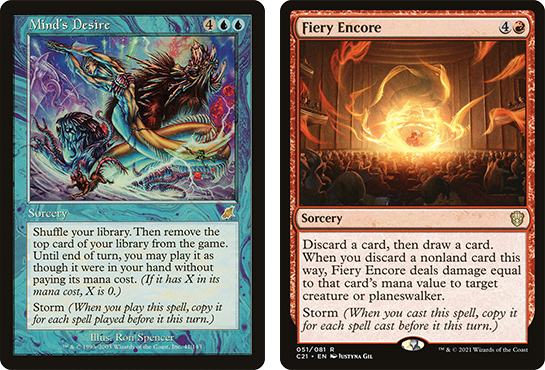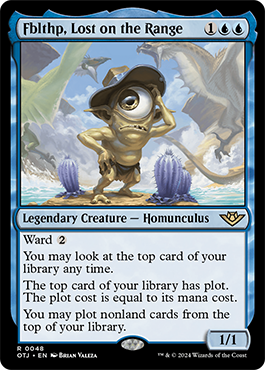Over the years, Magic has invented a multitude of mechanics to build decks around, each with its own unique advantages, dedicated support cards and memorable payoffs. But when all of those archetypes are thrown together into the grand melting pot of Commander, a few top-tier choices stand out. They offer versatile deck building options, consistent performance across different areas of the game and power ceilings which border on unbeatable.
This time we’re looking at storm, one of Magic’s all-time strongest mechanics, and Commander decks which embrace its distinctive playstyle. The archetype has natural synergy with a lot of the mechanics introduced in Outlaws of Thunder Junction, so the time seemed right to turn our eyes to the storm!
First printed in 2003’s Scourge expansion, the storm keyword multiplies the effect of the spells it appears on by the number of spells previously cast in the current turn. The majority of storm cards are designed as payoffs and win conditions, inviting players to construct the rest of their deck in a way which can chain spells together and build a very large “storm count” so the following payoff card is immediately lethal.
Storm-based decks were shaping the tournament metagame long before Commander was popularized. But their ability to generate explosive one-turn victories without needing to rely on specific cards or lines of play makes them uniquely well-suited to a singleton multiplayer format.
MOVING THE GOALPOSTS
It’s easiest to understand the unique potential of storm when we look at it in terms of resource exchange. Infinite combos usually arise from some set of cards which allow for a profitable, repeatable swap of one resource for another. Magic’s designers obviously try to balance costs and effects so this won’t happen under normal circumstances; going infinite usually requires a very particular combination of cards played together.
But the presence of storm spells in a deck fundamentally shifts this balance by turning “spells cast” into its own beneficial resource. Your plays no longer need to be infinitely profitable or even resource-positive at all; so long as they break even with their own costs and leave you in a position to play another spell, you’re accelerating ever close to the magic number where your storm spell will win the game.
Storm spells also break the mold by reducing your reliance on finding a second specific combo piece to secure victory. Your winning line of play is simply any sequence of sufficiently efficient, self-replacing spells, followed by a storm spell. It’s effectively a one-card combo – and since most storm spells will reliably win the game past a certain storm count, you can even run multiple interchangeable finishers in your deck.
This amazing flexibility and the resulting potential for creative gameplay have helped cement storm as one of the game’s all-time popular archetypes, both in Commander and beyond.
VIRTUOUS CYCLE
It’s all well and good to say that you can play any spells you like in your combo, but at some point you still need to choose which actual spells to sleeve up! Since storm can usually aim to be one of the fastest and most explosive decks at the table, there tends to be a bias towards effects which simply convert cards into mana or mana into cards – since that’s the easiest way to ensure they can chain together in whatever sequence you draw them.
The idea is that each mana ritual or draw spell leaves you with a slightly higher total of resources than you had before. The reality tends to be more uneven, with lower-quality spells hopefully doing enough to maintain momentum as you dig for highly broken outliers like Jeska’s Will, Peer into the Abyss, and Ad Nauseam. This explains the major role of tutors in storm: Grim Tutor may not look so mana-efficient, but grabbing the best ritual in your deck transforms it into a very positive play. Finding ways to recast your best spells from the yard exaggerates their massive upside even further.
If you don’t want to rely on the creme de la creme of resource generators, it’s equally viable to try and upgrade your returns from more average spells. The classic method is to use cost-reducers like Goblin Electromancer, Helm of Awakening, Semblance Anvil or the Medallion cycle. Since you’re casting so many spells in one turn, the total mana saved by these effects vastly outweighs what would be produced by a traditional mana rock. The same logic can apply to cast triggers, and resource generators like Storm-Kiln Artist, Archmage Emeritus and Runaway Steam-Kin will also do massive work during combo turns.
One other unique path worth mentioning dovetails nicely with those magecraft triggers in particular: copying effects. Making copies of spells will not increase your storm count (unless the copying effect says that you cast them), but it can massively boost your potential resources to continue playing other cards. One-off copiers like Reverberate and Twincast turn a huge profit when cloning more expensive spells like Mana Geyser.
Though rare, reusable copying effects like Cloven Casting, Bonus Round and Reiterate are massive force multipliers to the point of becoming win conditions in their own right. All of these little efficiency tricks can be mixed and matched to produce an ever more potent fuel, capable of launching your storm count well into the stratosphere!
COMMANDING THE ELEMENTS
Choosing a commander and color identity is the pivotal point where we can narrow down the wide-open possibilities of storm and position our deck in one of its distinct sub-styles.
The mainstream spellslinger builds typically need to be red and/or black, since only those colors have access to the explosive mana rituals the deck needs. Blue is often added for its many cantrips, defensive counterspells, and hyper-efficient draw like Windfall or Echo of Eons. Ideally the commander has some ability which adds momentum to the combo plan.
Rowan, Scion of War can completely unbalance your mana costs. Kess, Dissident Mage is a very consistent choice which produces a lot of bonus value over a full game, with a high ceiling if she recasts your best cards. Abaddon the Despoiler, Zethi, Arcane Blademaster and Lilah, Undefeated Slickshot can each add a significant number of free spells to your storm turn. Plot in general is a great fit for storm, and perhaps the biggest contribution Thunder Junction makes to the archetype.
Some off-beat storm choices allow you to combo with a focus on other card types. There are plenty of existing archetypes which naturally build a high storm count just by chaining together cheap permanents, be those elves, equipment, or expendable “bauble” style artifacts. All we’re doing is adding a commander which either weaponizes that storm count directly, like Thrasta, Tempest’s Roar and Aeve, Progenitor Ooze, or which accelerates the natural snowball of resources so we can eventually combo into a traditional storm kill: Gandalf the White, Karn, Legacy Reforged, Jhoira, Weatherlight Captain or Kinnan, Bonder Prodigy are great examples.
Weirdest of all are decks where your storm cards are simply a way to convert an otherwise non-lethal combo into a legitimate win condition. Some commanders have certain interactions which don’t actually impact the game state… but CAN be looped to generate an arbitrarily high storm count. Birgi, God of Storytelling can cast and bounce the same Grinning Ignus forever. Drafna, Founder of Lat-Nam just needs Training Grounds to loop Mox Amber or Mox Opal. Koll, the Forgemaster can slap Lightning Greaves or Shuko on a one-cost creature and feed it to Phyrexian Altar.
There are usually other ways you can convert these combos to a win using the right triggered ability or on-theme payoff. But a storm spell like Grapeshot or Brain Freeze offers a relatively cheap, immediate kill against any number of opponents, through most countermagic, potentially at instant speed, and without needing to rely on the vagaries of creature combat. Storm’s ability to fit in any deck means these cards form a de facto minimum power floor for combo finishers; anywhere the on-theme options don’t measure up (or aren’t numerous enough to draw consistently), storm spells can step in!
THE ETERNAL STORM
To its adherents, storm is an intricate and customizable puzzle-box, with a solution that changes every game but rewards you with eye-watering power. To its detractors, it can seem like a solipsistic denial of Magic; a deck which offers minimal opportunity to interact or even play a normal game, but which still drains long minutes of their lives as the storm pilot plods through their interminable yet inevitable combo kill.
So why does storm remain a tolerated, even celebrated archetype among the playerbase, when stax or land destruction decks are stigmatized for their similar effect on play? My guess is that, deep down, people just prefer games to end in a dramatic flurry of activity rather than a stultified freeze – even if that activity is all coming from one person.
Storm’s uniquely open-ended nature allows for endless improvisation in both decklists and gameplay, and Commander is a format in constant search of such novelty. Its total disregard for “fair Magic” means it won’t be a great fit at every table, especially since certain colors still struggle to interact meaningfully with its hand and stack. But the game-show excitement of a big storm turn is truly infectious, and one of the best demonstrations that fun in Magic is not, in fact, a zero-sum equation.

Tom’s fate was sealed in 7th grade when his friend lent him a pile of commons to play Magic. He quickly picked up Boros and Orzhov decks in Ravnica block and has remained a staunch white magician ever since. A fan of all Constructed formats, he enjoys studying the history of the tournament meta. He specializes in midrange decks, especially Death & Taxes and Martyr Proc. One day, he swears he will win an MCQ with Evershrike. Ask him how at @AWanderingBard, or watch him stream Magic at twitch.tv/TheWanderingBard.











